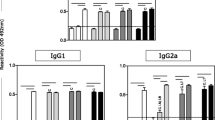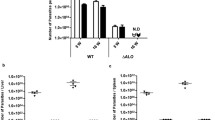Abstract
Experimental vaccines to protect against visceral leishmaniasis (VL) have been developed by using BALB/c mice infected with a large (107 to 108) inoculum of parasites. Remarkably, prior literature has reported that the poor protection observed is mainly due to the high susceptibility of this strain. To determine factors inherent to mice that might abrogate vaccine-induced efficacy, the present research sought to investigate the impact of the administration of different infective inoculums of Leishmania chagasi (syn. L. infantum) in BALB/c mice, evaluating subcutaneous and intravenous routes of administration as well as parasitological and immunological parameters over different periods of time. This study shows that the injection of a highly infective inoculum in mice, through both subcutaneous and intravenous routes, results in a sustained infection. The mice developed a high parasite load in the liver; however, these values diminished over time. This result did not corroborate with the parasite load in the bone marrow and brain and proved to be expressively different in the spleen and draining lymph nodes, where the values increased over time. Mice infected with a low dose of parasites (103) showed a certain resistance against infection, based mainly on the IFN-γ and oxide nitric production. Considering all the elements, it could be concluded that the models employing high doses (107) of L. chagasi in BALB/c mice can bring about an imbalance in the animals’ immune response, thus allowing for the development of the disease at the expense of efficacy within the vaccine candidates.



Similar content being viewed by others
References
Abreu-Silva AL, Calabrese KS, Tedesco RC, Mortara RA, Costa SCG (2003) Central nervous system involvement in experimental infection with Leishmania (Leishmania) amazonensis. Am J Trop Med Hyg 68:661–665
Afonso LC, Scott P (1993) Immune responses associated with susceptibility of C57BL/10 mice to Leishmania amazonensis. Infect Immun 61:2952–2959
Afrin F, Anam K, Ali N (2000) Induction of partial protection against Leishmania donovani by promastigoyes antigens in negatively charged liposomes. J Parasitol 89:730–735
Ahmed S, Colmenares M, Soong L, Goldsmith-Pestana K, Munstermann L, Molina R, McMahon-Pratt D (2003) Intradermal infection model for pathogenesis and vaccine studies of murine visceral leishmaniasis. Infect Immun 71:401–410
Barral A, Pedral-Sampaio D, Grimaldi G Jr, Momen H, McMahon-Pratt D, Ribeiro-de-Jesus A, Almeida R, Badaró R, Barral-Netto M, Carvalho EM, Johnson WD Jr (1991) Leishmaniasis in Bahia, Brazil: evidence that Leishmania amazonensis produces a wide spectrum of clinical disease. Am J Trop Med Hyg 44:536–546
Basu R, Bhaumik S, Haldar AK, Naskar K, De T, Dana SK, Walden P, Roy S (2007) Hybrid cell vaccination resolves Leishmania donovani infection by eliciting a strong CD8+ cytotoxic T-lymphocyte response with concomitant suppression of interleukin-10 (IL-10) but not IL-4 or IL-13. Infect Immun 75:5956–5966
Bhattacharyya S, Ghosh S, Jhonson PL, Bhattacharya SK, Majumdar S (2001) Immunomodulatory role of interleukin-10 in visceral leishmaniasis: defective activation of protein kinase C-mediated signal transduction events. Infect Immun 69:1499–1507
Bretscher PA, Wei G, Menon JN, Bielefeldt-Ohmann H (1992) Establishment of stable, cell mediated immunity that makes “susceptible” mice resistant to Leishmania major. Science 257:539–542
Carrión J, Nieto A, Iborra S, Iniesta V, Soto M, Folgueira C, Abanades DR, Requena JM, Alonso C (2006) Immunohistological features of visceral leishmaniasis in BALB/c mice. Parasite Immunol 28:173–183
Coelho EA, Tavares CA, Carvalho FA, Chaves KF, Teixeira KN, Rodrigues RC, Charest H, Matlashewski G, Gazzinelli RT, Fernandes AP (2003) Immune responses induced by the Leishmania (Leishmania) donovani A2 antigen, but not by the LACK antigen, are protective against experimental Leishmania (Leishmania) amazonensis infection. Infect Immun 71:988–994
Engwerda CR, Kaye PM (2000) Organ-specific immune responses associated with infectious disease. Immunol Today 21:73–78
Garcia-Alonso M, Nieto CG, Blanco A, Requena JM, Alonso C, Navarrete I (1996) Presence of antibodies in the aqueous humour and cerebrospinal fluid during Leishmania infections in dogs. Pathological features at the central nervous system. Parasite Immunol 18:539–546
Garg R, Dube A (2006) Animal models for vaccine studies for visceral leishmaniasis. Indian J Med Res 123:439–454
Himmelrich H, Launois P, Maillard I, Biedermann T, Tacchini-Cottier F, Locksley RM (2000) In BALB/c mice, IL-4 production during the initial phase of infection with Leishmania major is necessary and sufficient to instruct Th2 cell development resulting in progressive disease. J Immunol 164:4819–4825
Iniesta V, Gomez-Nieto LC, Corraliza I (2001) The inhibition of arginase by N(omega)-hydroxy-1-arginine controls the growth of Leishmania inside macrophages. J Exp Med 193:777–784
Iniesta V, Gómez-Nieto LC, Molano I, Mohedano A, Carcelén J, Mirón C, Alonso C, Corraliza I (2002) Arginase I induction in macrophages, triggered by Th2-type cytokines, supports the growth of intracellular Leishmania parasites. Parasite Immunol 24:113–118
Kaur S, Kaur T, Garg N, Mukherjee S, Raina P, Athokpam V (2008) Effect of dose and route of inoculation on the generation of CD4+ Th1/Th2 type of immune response in murine visceral leishmaniasis. Parasitol Res 103:1413–1419
Kaye PM, Gorak P, Murphy M, Ross S (1995) Strategies for immune intervention in visceral leishmaniasis. Ann Trop Med Parasitol 89:75–81
Keenan CM, Hendricks LD, Lightner L, Johnson AJ (1984) Visceral leishmaniasis in the German shepherd dog. I. Infection, clinical disease, and clinical pathology. Vet Pathol 21:74–79
Lehmann J, Enssle KH, Lehmann I, Emmendorfer A, Lohmann-Matthes ML (2000) The capacity to produce IFN-gamma rather than the presence of interleukin-4 determines the resistance and the degree of susceptibility to Leishmania donovani infection in mice. J Interferon Cytokine Res 20:63–77
Malafaia G, Serafim TD, Silva ME, Pedrosa ML, Rezende SA (2009) Protein–energy malnutrition decreases immune response to Leishmania chagasi vaccine in BALB/c mice. Parasite Immunol 3:41–49
McMahon-Pratt D, Alexander J (2004) Does the Leishmania major paradigm of pathogenesis and protection hold for New World cutaneous leishmaniasis or the visceral disease? Immunol Rev 201:206–224
Melby PC, Yang YZ, Cheng J, Zhao W (1998) Regional differences in the cellular immune response to experimental cutaneous or visceral infection with Leishmania donovani. Infect Immun 66:18–27
Melby PC, Tabares A, Restrepo BI, Cardona AE, McGuff HS, Teale JM (2001a) Leishmania donovani: evolution and architecture of the splenic cellular immune response related to control of infection. Exp Parasitol 99:17–25
Melby PC, Chandrasekar B, Zhao W, Coe JE (2001b) The hamster as a model of human visceral leishmaniasis: progressive disease and impaired generation of nitric oxide in the face of a prominent th1-like cytokine response. J Immunol 166:1912–1920
Muigai R, Gatei DG, Shaunak S, Wozniak A, Bryceson AD (1983) Jejunal function and pathology in visceral leishmaniasis. Lancet 2:476–479
Mukherjee P, Ghosh AK, Ghose AC (2003) Infection pattern and immune response in the spleen and liver of BALB/c mice intracardially infected with Leishmania donovani amastigotes. Immunol Letters 86:131–138
Murphy ML, Wille U, Villegas EN, Hunter CA, Farrell JP (2001) IL-10 mediates susceptibility to Leishmania donovani infection. Eur J Immunol 31:2848–2856
Murray HW, Stern JJ, Welte K, Rubin BY, Carriero SM, Nathan CF (1987) Experimental visceral leishmaniasis: production of interleukin 2 and interferon-gamma, tissue immune reaction, and response to treatment with interleukin-2 and interferon-gamma. J Immunol 138:2290–2297
Murray HW, Squires KE, Miralles CD, Stoeckle MY, Granger AM, Granelli-Piperno A, Bogdan C (1992) Acquired resistance and granuloma formation in experimental visceral leishmaniasis. Differential T cell and lymphokine roles in initial versus established immunity. J Immunol 148:1858–1863
Nieto CG, Viñuelas J, Blanco A, Garcia-Alonso M, Verdugo SG, Navarrete I (1996) Detection of Leishmania infantum amastigotes in canine choroid plexus. Vet Rec 139:346–347
Peters N, Sacks D (2006) Immune privilege in sites of chronic infection: Leishmania and regulatory T cells. Immunol Rev 213:159–179
Prasad LS, Sen S (1996) Migration of Leishmania donovani amastigotes in the cerebrospinal fluid. Am J Trop Med Hyg 55:652–654
Ramos CC, Duarte MI, Ramos AM (1994) Fatal visceral leishmaniasis associated with acquired immunodeficiency syndrome: report of a case with necropsy findings and immunohistochemical study. Rev Soc Bras Med Trop 27:245–250
Requena JM, Iborra S, Carrion J, Alonso C, Soto M (2004) Recent advances in vaccines for leishmaniasis. Expert Opin Biol Theraphy 4:1505–1517
Rhodes SG, Graham SP (2002) Is ‘timing’ important for cytokine polarization? Trends Immunol 23:246–249
Rolao N, Melo C, Campino L (2004) Influence of the inoculation route in BALB/c mice infected by Leishmania infantum. Acta Trop 90:123–126
Sacks DL, Melby PC (2001) Animal models for the analysis of immune responses to leishmaniasis. Curr Protoc Immunol 19:Unit 19.2
Stäger S, Joshi T, Bankoti R (2010) Immune evasive mechanisms contributing to persistent Leishmania donovani infection. Immunol Res 47:14–24
Toumanen E (1996) Entry of pathogens into the central nervous system. FEMS Microbiol Rev 18:289–299
Vieira LQ, Goldschmidt M, Nashleanas M, Pfeffer K, Mak T, Scott P (1996) Mice lacking the TNF receptor p55 fail to resolve lesions caused by infection with Leishmania major, but control parasite replication. J Immunol 157:827–835
Viñuelas J, Garcia-Alonso M, Fernando L, Navarrete I, Molano I, Mirón C, Carcelén J, Alonso C, Nieto CG (2001) Meningeal leishmaniosis induced by Leishmania infantum in naturally infected dogs. Vet Parasitol 101:23–27
Wilson ME, Jeronimo SM, Pearson RD (2005) Immunopathogenesis of infection with the visceralizing Leishmania species. Microb Pathog 38:147–160
Yazdanbakhsh M, Sacks DL (2010) Why does immunity to parasites take so long to develop? Nat Rev Immunol 10:80–81
Zanin FH, Coelho EA, Tavares CA, Marques-da-Silva EA, Costa MMS, Rezende SA, Gazzinelli RT, Fernandes AP (2007) Evaluation of immune responses and protection induced by A2 and nucleoside hydrolase (NH) DNA vaccines against Leishmania chagasi and Leishmania amazonensis experimental infections. Microbes Infect 9:1070–1077
Acknowledgments
This study was supported by grants from Pró-Reitoria de Pesquisa from UFMG (Edital 08/2011), Fundação de Amparo à Pesquisa do Estado de Minas Gerais (FAPEMIG; CBB-APQ-01322-08), Conselho Nacional de Desenvolvimento Científico e Tecnológico (CNPq; APQ-577483/2008-0), and Instituto Nacional de Ciência e Tecnologia em Nanobiofarmacêutica (INCT/Nano-BIOFAR), CNPq. DGV and EAFC are grant recipients of CNPq, while DMO, MAFC, and MACF are grant recipients of Coordenação de Aperfeiçoamento de Pessoal de Nível Superior (CAPES).
Author information
Authors and Affiliations
Corresponding author
Rights and permissions
About this article
Cite this article
Oliveira, D.M., Costa, M.A.F., Chavez-Fumagalli, M.A. et al. Evaluation of parasitological and immunological parameters of Leishmania chagasi infection in BALB/c mice using different doses and routes of inoculation of parasites. Parasitol Res 110, 1277–1285 (2012). https://doi.org/10.1007/s00436-011-2628-5
Received:
Accepted:
Published:
Issue Date:
DOI: https://doi.org/10.1007/s00436-011-2628-5




